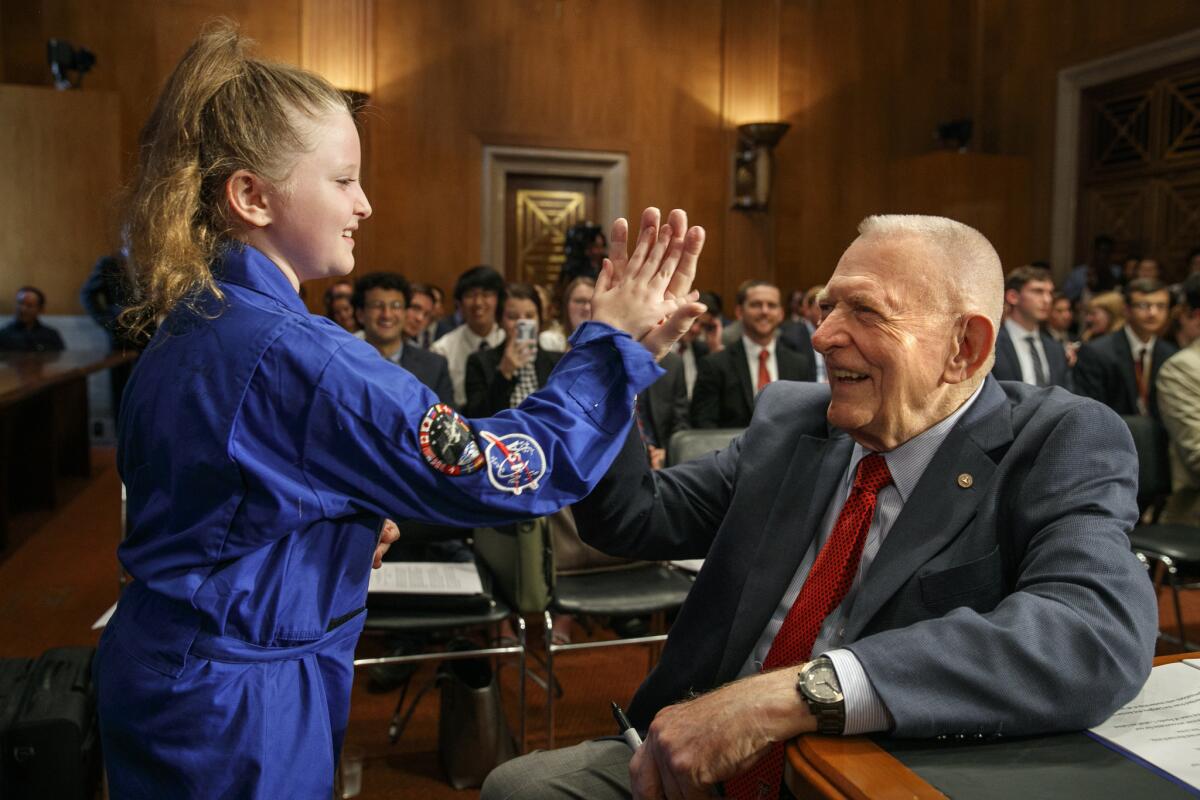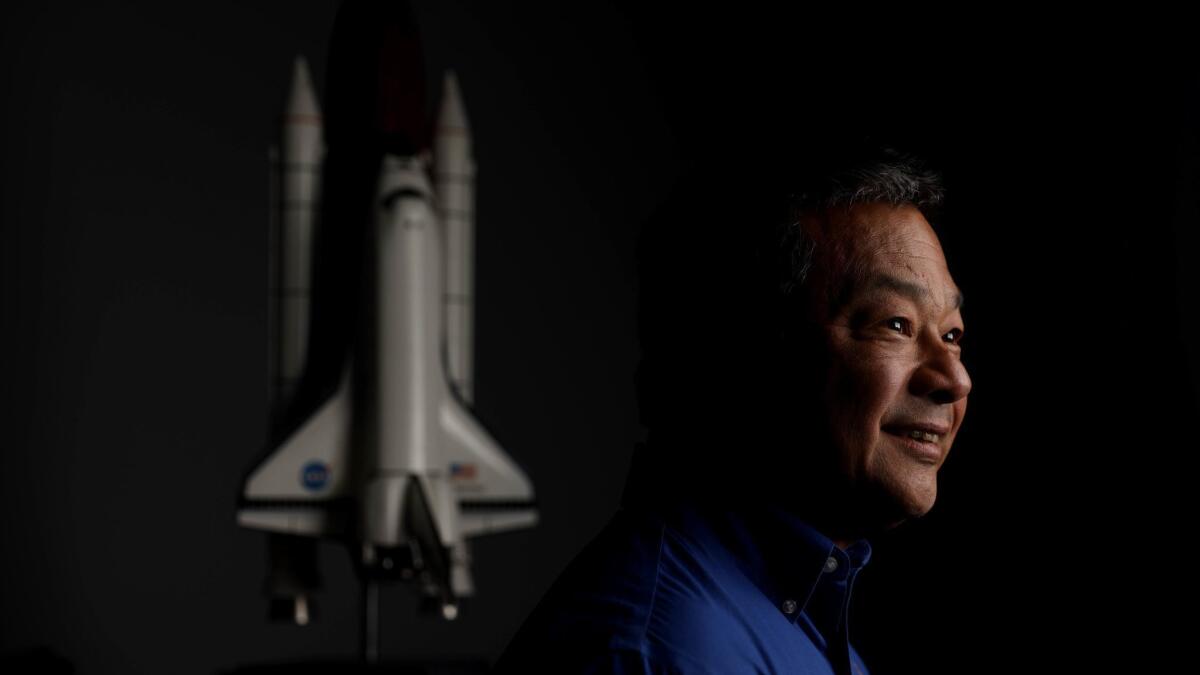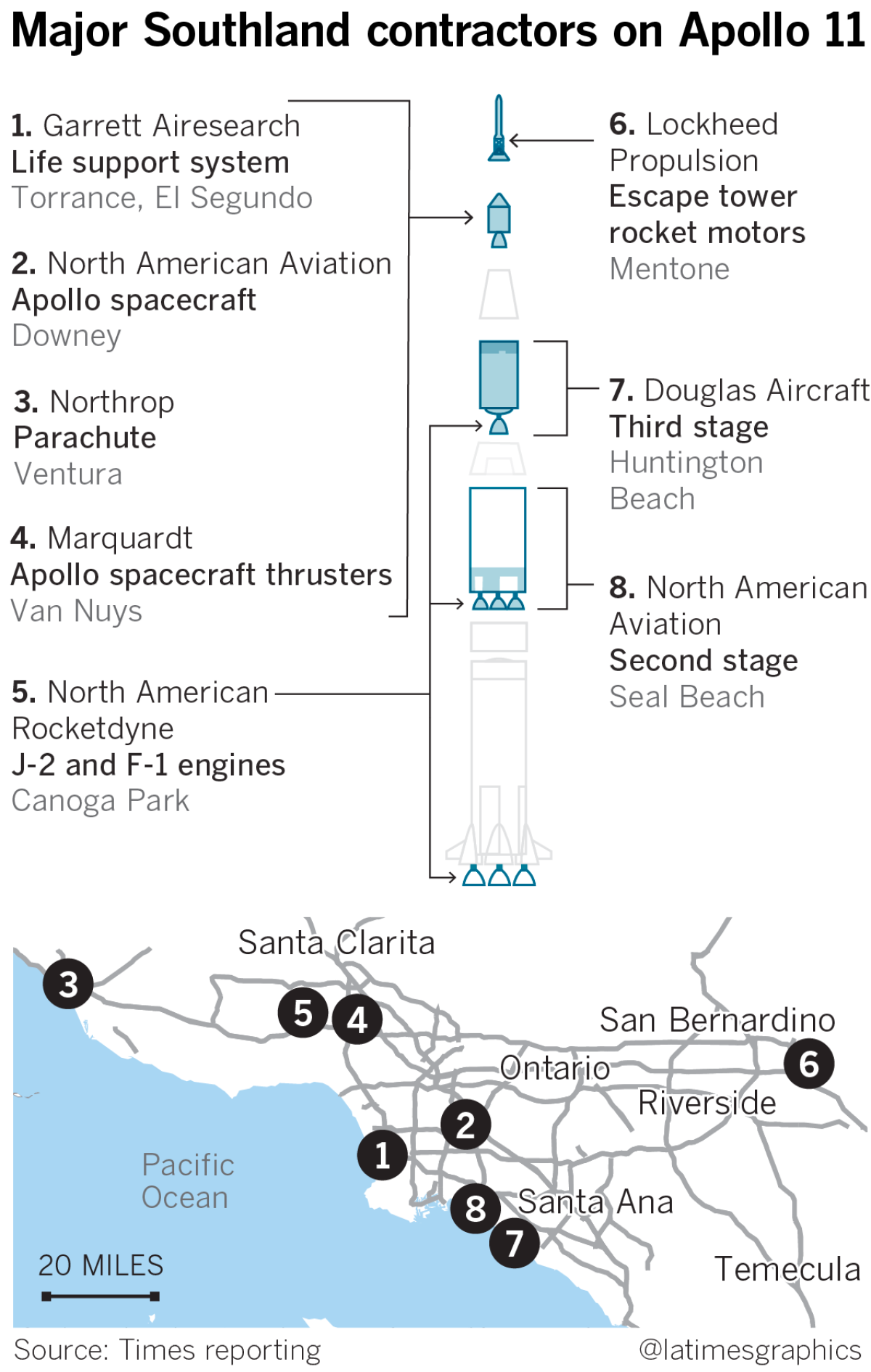Could the Apollo 11 moon landing be duplicated today? ‘Lots of luck with that’
- Share via
The passage of half a century has blurred many of the reasons that the United States was able to accomplish what seemed like science fiction: the July 20, 1969, landing of Apollo 11 on the moon.
The Apollo program’s stunning technical success depended on a government leadership culture, an industrial organization, a tolerance for risk and a political environment that do not exist today — even as NASA insists it will land humans on the moon in five years.
Could it be duplicated? “Lots of luck with that,” said Jay Honeycutt, an Apollo-era engineer in flight operations who later became chief of the Kennedy Space Center in Florida. “We could if they let us.”
Honeycutt was among more than a dozen Apollo-era leaders and contemporary space experts who agreed, in interviews, that changes in American society have made the idea of landing humans on the moon far more challenging now than it was 50 years ago.
“Technically it would be easier today, because we have more tools,” said Gerry Griffin, an Apollo-era flight director who later became chief of the Johnson Space Center in Texas. “Politically and financially it would be a different question. I am not sure we could ever get that reestablished.”
“It is easier to build a spacecraft than to build a team,” said Eugene Kranz, mission director of Apollo 11. “You have enough knowledge in the industry, but you need top-level leadership that is capable of knocking heads to get people to work as a team.”

These legends of the Apollo era say the most important ingredient of the moon landing was not the technology, though it was one of the greatest bursts of engineering in human history, but the management, national commitment and personal motivation of the participants.
“I fear that we no longer have the ability to do what we did in the 1960s,” wrote Don Eyles, a mathematics graduate who in his 20s helped produce the navigation software for the lunar module. Until then, “nobody knew much about programming a spacecraft guidance computer,” so the job went to someone just out of college, one player in a project that employed 400,000 Americans.
“We haven’t had the conviction since then,” he said in an interview.
The current NASA administrator, Jim Bridenstine, takes a far more optimistic view, saying technology would make the journey safer and cheaper than in the 1960s. He is overseeing a plan to return to the moon by 2024 and put a female astronaut on its south pole to investigate frozen water there.
Though Bridenstine is confident and believes private investors will help support his effort, many past attempts to reinvigorate the human space program have started on high hopes and fizzled.
The success of Apollo 11 depended on a lot of things that seem unlikely or intolerable today.
It was an era of unquestioning trust of young engineers, trial-and-error design, blank checks to big aerospace corporations and gruff management practices. When mistakes were made, scapegoats were found.
These were years of 60-to-80-hour work weeks. Engineers were run ragged. There were ulcers, heart attacks, heavy drinking, chain smoking, abandoned families, divorces and the ever-looming threat that the Soviet Union would steal the prize. And one other layer of complexity: valuable contributions from a staff of German rocket scientists who had worked for Adolf Hitler before their capture by the U.S. Army in World War II.
Much of this management culture would be politically incorrect in 2019, a fact that Kranz readily acknowledged. “This would be a problem today,” he said.
The country’s social needs were set aside to provide NASA funding that at its peak reached an inflation-adjusted $47 billion or more in a single year. NASA consumed 4.5% of the federal budget, compared with about 0.5% today, meaning that if it were to have the same share now its budget would not be the current $21.5 billion, but nearly $200 billion.
But the motivation then was the Cold War. The Soviet Union had humiliated the United States by launching the first satellite in 1957 and then the first human into orbit in 1961. To a world split between West and East, the Soviet breakthroughs argued that communism could outperform capitalism.
In a landmark 1962 speech at Rice University, President Kennedy said, “No nation which expects to be the leader of other nations can expect to stay behind in the race for space.”
The speech is widely regarded as the most moving and powerful explanation for space exploration, delivered in a style that only Kennedy could accomplish, detailed but sweeping, cautious but aggressive. It would cost every man, woman and child 40 cents that year, Kennedy said, and the cost would rise to 50 cents ($4.27 in today’s dollars) the next year.
The space race gave a political justification for the project, but most likely played little role in its success.
“People say the reason Apollo was successful is that we were trying to beat the Russians,” Honeycutt said. “That may have been true in Washington, but I can tell you in the Mission Control Center and the other centers, beating the Russians was not in anybody’s mind.”
What did make the space program succeed, in part, was that it took place at an extraordinary moment in American history when youth were playing a bigger and more influential role than ever before, exemplified by a young president, a youth culture that demanded change and an army of young engineers who wanted to remake the world.
“We had flight controllers who were straight out of college,” Griffin said. “We had all these young guys who were raring to go. The leadership pushed decisions down in the organization, they didn’t elevate them. They trusted people below them. The idea was, let’s not worry about who gets credit; let’s not second-guess everybody. We knew the topics better than they did. That’s not what we have now. I could feel it in NASA before I left.”
Another change in NASA since then has been its higher safety margins — in other words, its aversion to risk.
“People get more and more into risk-avoidance,” said Honeycutt. “You don’t want to be unsafe, but there is only one way to be completely safe and that is not to launch. As you move up the chain, acceptance of risk gets tighter and tighter.”
With today’s thinking, Honeycutt said, the lunar program would have been canceled after the near disaster of Apollo 13, when an explosion damaged the spacecraft part way to the moon. It was the quick thinking of the NASA flight staff under the direction of Kranz that ensured the crew’s safe return.
Advanced technology certainly does not guarantee safety. Boeing, one of the nation’s top engineering organizations, has grounded its most important product, the 737 Max jetliner, because of both software system defects and management errors that caused two passenger jet crashes on foreign airlines, for example.
Among outsiders, there are darker concerns about what the changes at NASA represent about the nation.
“The way our society has changed, it is not clear whether we are equipped to make use of scientific and engineering resources,” said James Moore, a USC engineering professor who decided to become an engineer because of the Apollo moon landing. “Public authority seems to be more focused on process and less focused on performance.”
The Apollo program depended critically on political support, though it took a lot of bartering to ensure it. Kennedy needed the backing of conservative Southern Democrats, so NASA made big investments in the South. By the time of Apollo 11, it had its human spaceflight center in Houston, an engine test facility in Mississippi, a spaceflight center that hosted the German scientists in Alabama, the launch center at Florida’s Cape Canaveral and the original center of NASA operations in southern Virginia.
“It wasn’t an accident, you can bet on it,” said Sean O’Keefe, NASA administrator during the presidency of George W. Bush who is now a professor at Syracuse University.
But the political landscape and the ability to forge coalitions have changed.
“There was no partisanship on the [House] Science Committee,” said Don Fuqua, the Florida Democrat who chaired the House human spaceflight subcommittee during the latter part of the Apollo program, and later the full Science Committee. “I never took anything to the House floor that the ranking member [New Mexico Republican Manuel Lujan Jr.] and I did not agree on. We were good personal friends. We went to launches together. We went to dinner together. Our wives were good friends.”
“I don’t think we could have that collaboration today,” he added. “If you cross the aisle to talk to somebody, it is like collaborating with the enemy.”
The other critical ingredient in the Apollo program was that it offered a nonmilitary goal for many young engineers who were opposed to the Vietnam War.
“I always saw space as the opposite to building strategic weapons,” said Eyles, the guidance computer programmer who recently wrote the book “Sunburst and Luminary,” a personal account of the Apollo program. In that era, he and others from the Charles Stark Draper Laboratory would attend antiwar rallies. Today, he is disappointed that liberals are not stronger supporters of human spaceflight, asserting, “When was America ever stronger than after we landed on the moon?”
Efforts to grow the human spaceflight mission have repeatedly foundered. The U.S. space agency has not fully developed a new rocket engine since the space shuttle in the 1970s, and the industrial base has withered.
In 2004, President Bush announced development of the Orion spacecraft and Ares launch system that he said would help U.S. astronauts return to the moon as soon as 2015 as a first step to Mars.
NASA began work on the program in 2005, but schedule delays and cost increases piled up. In 2009, an independent review panel ordered by the Obama administration found the program faced a “mismatch between funding and program content” from the beginning.
“It was not funded to the level it needed to be in order to be successful,” said Leroy Chiao, a former astronaut who was on the committee. “It kind of got further and further behind as the program went on.”

In 2010, President Obama canceled the Constellation program, setting a new goal of a human landing on an asteroid using parts left over from main engines on the space shuttle and an enlarged version of the space shuttle solid rocket booster.
Those would be coupled with the Orion capsule that could carry four astronauts. It is this foundation that NASA is planning to use for the lunar mission in 2024.
“It is a new rocket, and anytime you build something new, you’re going to have development that’s complicated,” said Wayne Hale, former NASA space shuttle program manager and later a deputy associate administrator at the agency. “The real problem is this idea that we’re going to make this very complicated rocket on a shoestring budget.”
Public support for returning to the moon also is not the same as in the 1960s. A Pew Research poll last year found that only 13% of Americans thought putting astronauts on the moon should be a top NASA priority; the majority said the agency should focus on monitoring climate or tracking asteroids.
Bridenstine, the NASA chief, said it will cost far less to return to the moon, thanks to the investments made in the 1960s and to the lower cost of electronics today. He puts the cost at $20 billion or less, not including the $10.5 billion spent annually on the human spaceflight program that largely supports the International Space Station. But so far, the agency has requested only $1.6 billion of that $20-billion requirement.
But he is optimistic and says the private sector is eager to invest in the project. “We didn’t know there was water ice on the moon until 2009,” he said. “What else is there that we don’t know?”
Where genuine breakthroughs have occurred, it has not been in the NASA human spaceflight program.
Commercial space companies, such as Elon Musk’s SpaceX, have risen to prominence. The Hawthorne-based company currently carries cargo for NASA to the space station with its Falcon 9 rockets and Dragon cargo capsule, and will soon use those rockets and a Crew Dragon vehicle to ferry astronauts to the station.
That mysterious light in the sky? It was a SpaceX launch »
SpaceX stunned the aerospace industry in 2015 when it vertically landed a first-stage booster back on land. Since then, it has landed boosters more than 40 times and has flown previously used boosters more than 20 times.
The SpaceX culture has parallels with 1960s-era NASA. Significant input comes from the lowest parts of the organization, and its employees tend to be “a young group that doesn’t really know what’s impossible because they haven’t been beaten down,” said Garrett Reisman, a former NASA astronaut who is a senior advisor for the company and teaches at USC. “They go out and do impossible things.”
And NASA’s unmanned probes and orbital observatories are a point of national pride. NASA, led by the Jet Propulsion Laboratory in La Cañada Flintridge, has landed eight increasingly sophisticated generations of machines on Mars. But even those accomplishments had to overcome changes in the NASA organization.

“At NASA, there is a whole lot more bureaucracy than there was in the 1970s or even the 1980s,” said Charles Elachi, who led JPL for 15 years ending in 2016. “It would take months to years to make decisions on something that could be done in weeks.”
JPL and SpaceX, among other organizations, are part of an industry that has flourished in Southern California for more than a century. During Apollo, it was responsible for the most important components of the spacecraft. The project depended on the unique chemistry of the Southern California industry.
North American Aviation, a pioneer of the jet age and builder of the X-15 rocket plane, had the contracts to build the Apollo command capsule and service module in Downey, the advanced liquid hydrogen engines in Canoga Park and the ultra-lightweight Saturn V second-stage rocket in Seal Beach. Douglas Aircraft was building the third stage in Huntington Beach. Many of those facilities, including the Rocketdyne engine factory in Canoga Park, and the highly skilled people in them are gone.
At its peak, North American Aviation was hiring 1,000 engineers a month, according to the history told in “Angle of Attack,” a 1992 book by Mike Gray. The project had 30,000 workers in Downey alone. Harrison Storms headed the company’s space division, a group of hard-charging and often heavy-drinking executives. As others, he fell victim to a heart attack and disobeyed his doctor’s orders when he returned to the Downey factory.
The spacecraft, built with the precision of a watch, contained 2 million parts. Storms was made the scapegoat for the Apollo 1 fire in January 1967, which killed three astronauts — though the decision that caused the fire, to use a pure oxygen environment at high pressure, was made by NASA. But the program didn’t pause long. After a year and a half delay, it was back on track for the first launch.
In 1969, Apollo flew four times, including two landings on the moon. In total, Apollo took astronauts to the moon’s surface six times, ending in late 1972 with Apollo 17.
“When we landed Apollo 17, we thought it would be a few years before we went back,” said Apollo-era flight controller Jerry Bostick. “But here it is 47 years since we were there, and I don’t think I will see it in my lifetime. I am not sure all the dominoes will line up again — the management, the public support, the competition with Russia or somebody else.”
Do you remember the 1969 moon landing? We want to hear from you »
Follow me on Twitter @rvartabedian
More to Read
Sign up for Essential California
The most important California stories and recommendations in your inbox every morning.
You may occasionally receive promotional content from the Los Angeles Times.












